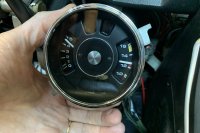I just installed a new VDO oil pressure gauge in the spot where the clock used to be. So I’m using the positive wire from the clock to go to the positive of the oil gauge. One problem there, obviously, is that the gauge is now powered all the time. So I will have to use a switched power source instead.
But in the meantime my question is that whenever I turn the battery on (not the motor) the needle goes almost all the way up to 5 bar. Shouldn’t the gauge stay at zero until oil pressure is being sent from the sensor to the gauge?
The sensor is new and has one output for oil pressure gauge and the other for the idiot light. The idiot light portion works just fine, so I’m assuming the sensor itself is fine. I have not turned the engine on yet just in case this is an indication that something is wrong.
Any thoughts?
Bo.
But in the meantime my question is that whenever I turn the battery on (not the motor) the needle goes almost all the way up to 5 bar. Shouldn’t the gauge stay at zero until oil pressure is being sent from the sensor to the gauge?
The sensor is new and has one output for oil pressure gauge and the other for the idiot light. The idiot light portion works just fine, so I’m assuming the sensor itself is fine. I have not turned the engine on yet just in case this is an indication that something is wrong.
Any thoughts?
Bo.


